DODGE DURANGO 2022 Vehicle Warranty
Manufacturer: DODGE, Model Year: 2022, Model line: DURANGO, Model: DODGE DURANGO 2022Pages: 200, PDF Size: 6.72 MB
Page 51 of 200

BRIDGESTONE® - FIRESTONE®
50
pressure, load, tire condition (including damage), wear, vehicle condition (including
alignment), driving conditions, and duration at which the speed is sustained. Use the
following chart to compare the speed ratings of tires.
The tire’s speed rating designation appears on the tire sidewall with the tire size.
Ex
amples:
* In standardized laboratory tests that relate to highway speeds. Actual tire speed and performance
capability depend on factors such as inflation pressure, load, tire condition, wear, and driving conditions.
** Any tire having a maximum speed capability above 149 mph (240 km/h) may, at the tire manufacturer’s
d i
scretion, include a “Z” in the size designation (i.e. P275/40ZR17).
*** For tires having a maximum speed capability above 186 mph (300 km/h), a “Z” must appear in the size
d e
signation and a “Y” marked in brackets (as shown) in the service description.
**** Consult the tire manufacturer for maximum speed capability.
Speed
Symbol Speed Category*
mph km/h
M 81130
Q 99160
R 106 170
S 112 180
T 118 190
U 124 200
H 130 210
V 149 240
Z** >149 >240
W 168 270
Y 186 300
(Y)*** >186
P275/40ZR17 max > 149 mph (240 km/h)****
P275/40R17 93Wmax = 168 mph (270 km/h)
P275/40ZR17 93Wmax = 168 mph (270 km/h)
P275/40ZR17 93Ymax = 186 mph (300 km/h)
P275/40ZR17 93(Y)max > 186 mph (300 km/h) ****
Page 52 of 200
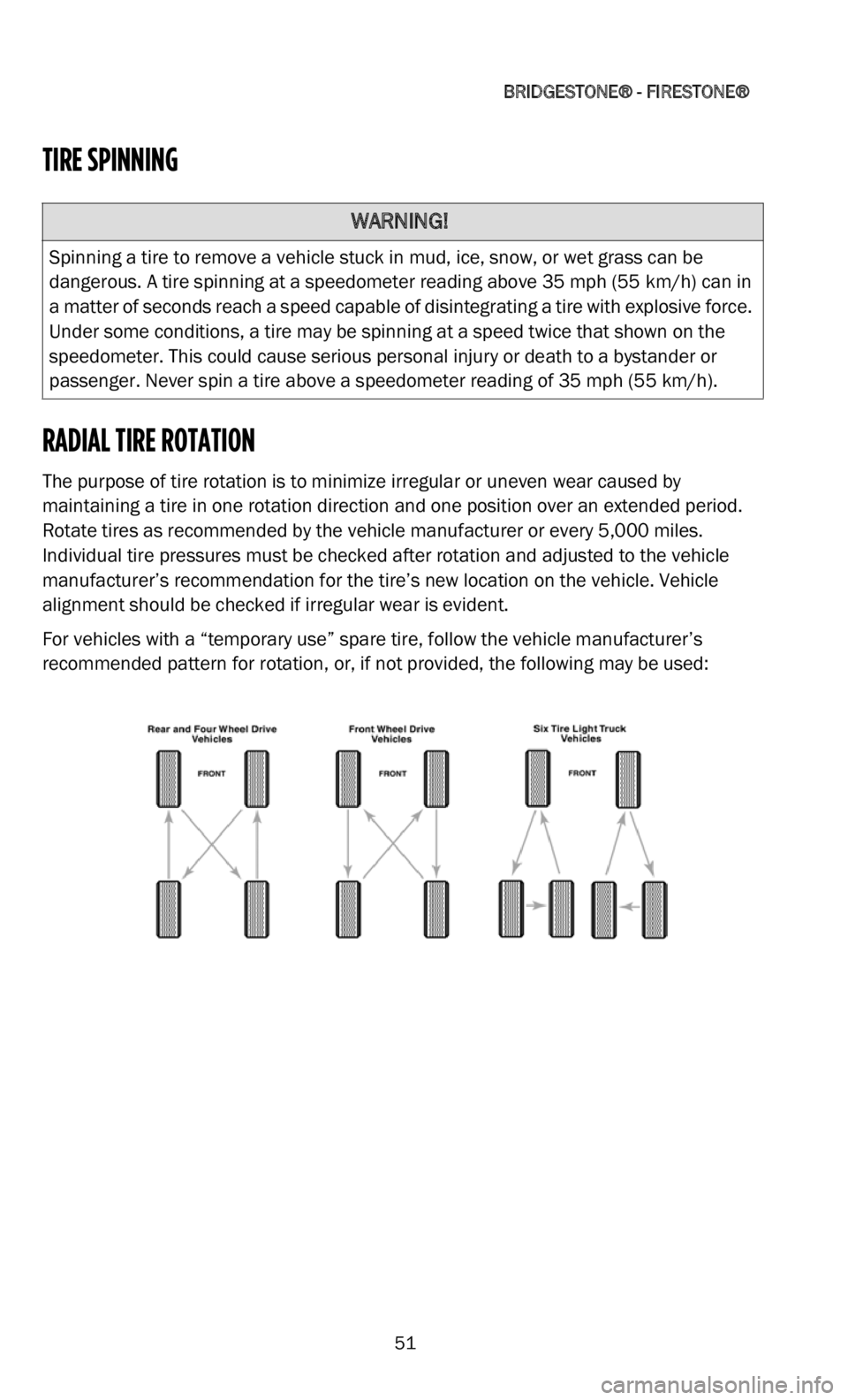
BRIDGESTONE® - FIRESTONE®
51
TIRE SPINNING
RADIAL TIRE ROTATION
The purpose of tire rotation is to minimize irregular or uneven wear caused by
maintaining a tire in one rotation direction and one position over an extended period.
Rotate tires as recommended by the vehicle manufacturer or every 5,000 miles.
I n
dividual tire pressures must be checked after rotation and adjusted to the vehicle
manufacturer’s recommendation for the tire’s new location on the vehicle. Vehicle
alignment should be checked if irregular wear is evident.
For vehicles with a “temporary use” spare tire, follow the vehicle manufacturer’s
r e
commended pattern for rotation, or, if not provided, the following may be used:
WARNING!
Spinning a tire to remove a vehicle stuck in mud, ice, snow, or wet grass can be
dangerous. A tire spinning at a speedometer reading above 35 mph (55 km/h) can in
a
matter of seconds reach a speed capable of disintegrating a tire with explosive force.
Under some conditions, a tire may be spinning at a speed twice that shown on the
speedometer. This could cause serious personal injury or death to a bystander or
passenger. Never spin a tire above a speedometer reading of 35 mph (55 km/h).
Page 53 of 200
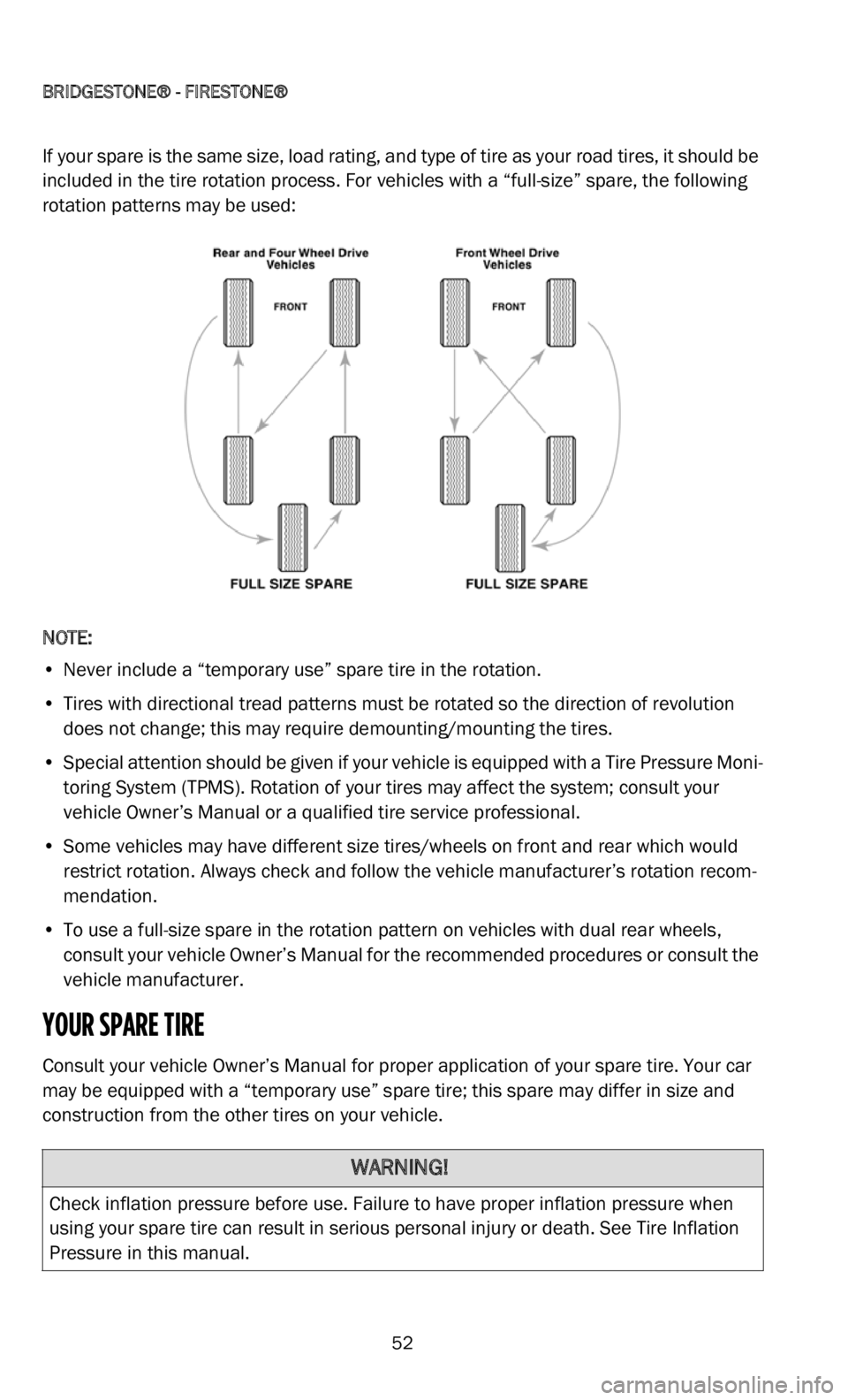
BRIDGESTONE® - FIRESTONE®
52
If your spare is the same size, load rating, and type of tire as your road tires, it should be
included in the tire rotation process. For vehicles with a “full-size” spare, the following
rotation patterns may be used:
NOTE:
• Never include a “temporary use” spare tire in the rotation.
•
Tires with directional tread patterns must be rotated so the direction of revolution
d
oes not change; this may require demounting/mounting the tires.
• S pecial attention should be given if your vehicle is equipped with a Tire Pressure Moni -
t
oring System (TPMS). Rotation of your tires may affect the system; consult your
v e
hicle Owner’s Manual or a qualified tire service professional.
• S ome vehicles may have different size tires/wheels on front and rear which would
r
estrict rotation. Always check and follow the vehicle manufacturer’s rotation recom -
mendation.
• T o use a full-size spare in the rotation pattern on vehicles with dual rear wheels,
c
onsult your vehicle Owner’s Manual for the recommended procedures or consult the
vehicle manufacturer.
YOUR SPARE TIRE
Consult your vehicle Owner’s Manual for proper application of your spare tire. Your car
may be equipped with a “temporary use” spare tire; this spare may differ in size and
construction from the other tires on your vehicle.
WARNING!
Check inflation pressure before use. Failure to have proper inflation pressure when
using your spare tire can result in serious personal injury or death. See Tire Inflation
Pressure in this manual.
Page 54 of 200
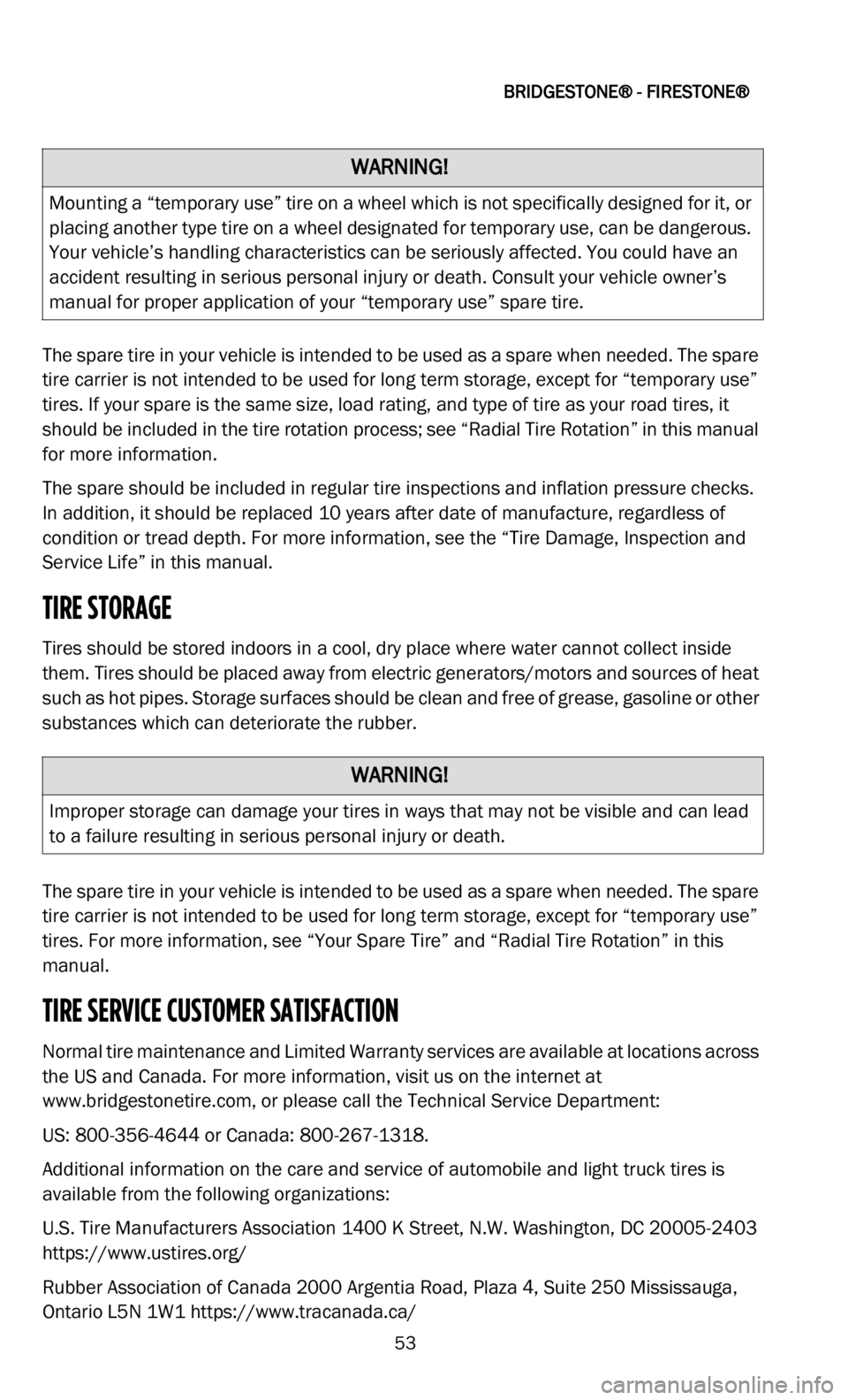
BRIDGESTONE® - FIRESTONE®
53
The spare tire in your vehicle is intended to be used as a spare when needed. The spare
tire carrier is not intended to be used for long term storage, except for “temporary use”
tires. If your spare is the same size, load rating, and type of tire as your road tires, it
should be included in the tire rotation process; see “Radial Tire Rotation” in this manual
for more information.
The spare should be included in regular tire inspections and inflation pressure checks.
In
addition, it should be replaced 10 years after date of manufacture, regardless of
condition or tread depth. For more information, see the “Tire Damage, Inspection and
Service Life” in this manual.
TIRE STORAGE
Tires should be stored indoors in a cool, dry place where water cannot collect inside
them. Tires should be placed away from electric generators/motors and sources of heat
such as hot pipes. Storage surfaces should be clean and free of grease, gasoline or other
substances which can deteriorate the rubber.
The spare tire in your vehicle is intended to be used as a spare when needed. The spare
t i
re carrier is not intended to be used for long term storage, except for “temporary use”
tires. For more information, see “Your Spare Tire” and “Radial Tire Rotation” in this
manual.
TIRE SERVICE CUSTOMER SATISFACTION
Normal tire maintenance and Limited Warranty services are available at locations across
the US and Canada. For more information, visit us on the internet at
www.bridgestonetire.com , or please call the Technical Service Department:
US: 8 00-356-4644 or Canada: 800-267-1318.
A
dditional information on the care and service of automobile and light truck tires is
a v
ailable from the following organizations:
U.S. Tire Manufacturers Association 1400 K Street, N.W. Washington, DC 20005-2403
https://www.ustires.org/
Rubber Association of Canada 2000 Argentia Road, Plaza 4, Suite 250 Mississauga,
O n
tario L5N 1W1 https://www.tracanada.ca/
WARNING!
Mounting a “temporary use” tire on a wheel which is not specifically designed for it, or
placing another type tire on a wheel designated for temporary use, can be dangerous.
Your vehicle’s handling characteristics can be seriously affected. You could have an
accident resulting in serious personal injury or death. Consult your vehicle owner’s
manual for proper application of your “temporary use” spare tire.
WARNING!
Improper storage can damage your tires in ways that may not be visible and can lead
to a failure resulting in serious personal injury or death.
Page 55 of 200
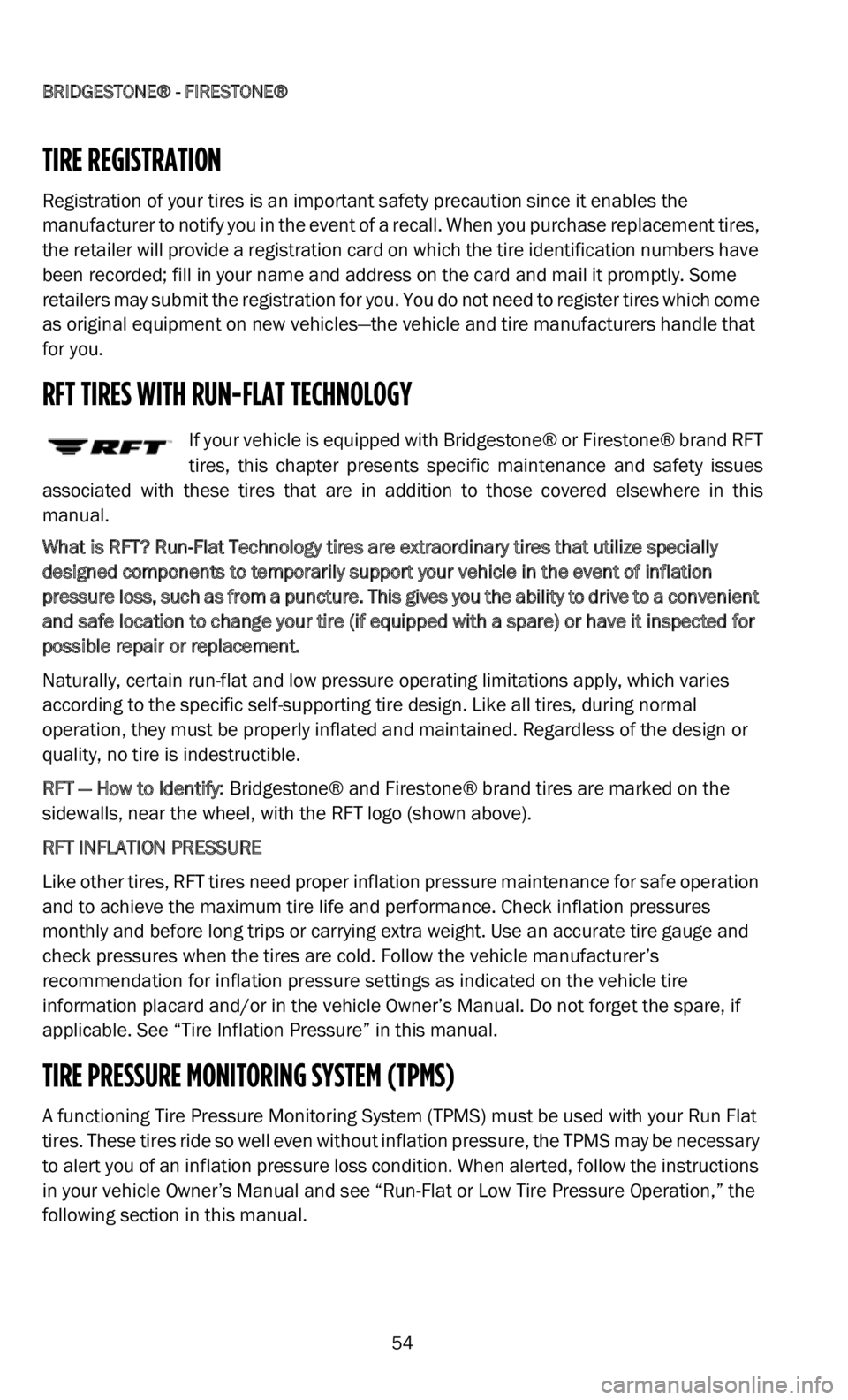
BRIDGESTONE® - FIRESTONE®
54
TIRE REGISTRATION
Registration of your tires is an important safety precaution since it enables the
manufacturer to notify you in the event of a recall. When you purchase replacement tires,
the retailer will provide a registration card on which the tire identification numbers have
been recorded; fill in your name and address on the card and mail it promptly. Some
retailers may submit the registration for you. You do not need to register tires which come
as original equipment on new vehicles—the vehicle and tire manufacturers handle that
for you.
RFT TIRES WITH RUN-FLAT TECHNOLOGY
If your vehicle is equipped with Bridgestone® or Firestone® brand RFT
tires, this chapter presents specific maintenance and safety issues
a s
sociated with these tires that are in addition to those covered elsewhere in this
manual.
What is RFT? Run-Flat Technology tires are extraordinary tires that utilize specially
d e
signed components to temporarily support your vehicle in the event of inflation
pressure loss, such as from a puncture. This gives you the ability to drive to a convenient
and safe location to change your tire (if equipped with a spare) or have it inspected for
possible repair or replacement.
Naturally, certain run-flat and low pressure operating limitations apply, which varies
ac
cording to the specific self-supporting tire design. Like all tires, during normal
operation, they must be properly inflated and maintained. Regardless of the design or
quality, no tire is indestructible.
RFT — How to Identify: B
ridgestone® and Firestone® brand tires are marked on the
sidewalls, near the wheel, with the RFT logo (shown above).
RFT INFLATION PRESSURE
Like other tires, RFT tires need proper inflation pressure maintenance for safe operation
an
d to achieve the maximum tire life and performance. Check inflation pressures
monthly and before long trips or carrying extra weight. Use an accurate tire gauge and
check pressures when the tires are cold. Follow the vehicle manufacturer’s
recommendation for inflation pressure settings as indicated on the vehicle tire
information placard and/or in the vehicle Owner’s Manual. Do not forget the spare, if
applicable. See “Tire Inflation Pressure” in this manual.
TIRE PRESSURE MONITORING SYSTEM (TPMS)
A functioning Tire Pressure Monitoring System (TPMS) must be used with your Run Flat
tires. These tires ride so well even without inflation pressure, the TPMS may be necessary
to alert you of an inflation pressure loss condition. When alerted, follow the instructions
in your vehicle Owner’s Manual and see “Run-Flat or Low Tire Pressure Operation,” the
following section in this manual.
Page 56 of 200

BRIDGESTONE® - FIRESTONE®
55
The vehicle or TPMS manufacturer may advise checking the TPMS regularly to confirm it
is in working order. In addition, a new pressure sensor, certain components, or
reprogramming may be necessary when a tire is serviced. Consult your vehicle Owner’s
Manual, vehicle manufacturer, or a Bridgestone® Firestone® Run-Flat Certified Retailer
for questions regarding TPMS operation and service.
RUN-FLAT OR LOW TIRE PRESSURE OPERATION
General Instructions
The Tire Pressure Monitoring System (TPMS) required in your vehicle may have different
m e
thods of alerting you when your tire has lost inflation pressure. The international
standard for the definition of run-flat operation is pressure at or below 10 psi (70 kPa);
however, some vehicle manufacturers may have established a different pressure limit.
Consult your vehicle Owner’s Manual for the details of your TPMS. Once the TPMS has
indicated that a tire has reduced inflation pressure, the run-flat mode of operation has
commenced. During this phase of operation, please follow these instructions:
• Reduce speed as much as safely and reasonably possible; do not exceed 50 m
ph
(8
0 km/h). The greater the speed, the less distance the tire can travel.
• Avoid abrupt or aggressive acceleration, braking, or cornering maneuvers as much as
s
afely and reasonably possible. Pot holes and other road hazards should be avoided.
Careful driving limits potential damage to the tire, wheel, and vehicle.
• Proceed to a safe and convenient location for tire service as soon as possible.
Take
note of your mileage; your operation distance is limited. See "Distance—How Far You
Can Drive,” the next section in this manual.
• If an unusual vibration or vehicle handling difficulty arises, stop driving as soon as
s
afely and reasonably possible. The tire may be about to suddenly fail. Release the
accelerator and gradually reduce speed. The tire will need to be replaced before
proceeding.
• If towing a trailer, stop driving as soon as safely and reasonably possible. In this condi -
t
ion, it is potentially dangerous to operate a vehicle/trailer combination. I
f possible,
disconnect the trailer and proceed as noted above. Do not continue to tow any trailer
until proper tire service or replacement has been performed.
• Do not touch a tire recently run-low or run-flat (it may be very hot).
Allow the tire to cool
before handling.
WARNING!
Serious personal injury or death may result from a tire failure or accident due to
improper run-flat or low tire pressure operation. Read and follow the instructions
below, and the other maintenance and safety recommendations elsewhere in this
manual.
Page 57 of 200

BRIDGESTONE® - FIRESTONE®
56
DISTANCE—HOW FAR YOU CAN DRIVE
Factors affecting run-flat or low tire pressure operating distance include vehicle speed,
load, and maneuvering; the amount of inflation pressure loss; the extent of any tire
damage; and ambient temperature.
The tire may be marked on the sidewall with run-flat or low tire pressure operating speed
an
d/or distance limitations, which vary by tire design and vehicle application (consult
your vehicle owner’s manual). By international standard, RFT tires have a baseline
limitation in run-flat mode of the following:
NOTE:
• M aximum distance values are determined under controlled conditions, which may
v
ary in actual use.
• Y our mileage capability may be less, or more, depending on your specific operating
c
onditions.
• I f in doubt, do not exceed the 50
mile (80 km) limitation.
• S eek tire service as soon as possible to minimize tire damage.
SPECIAL SERVICE AND REPAIR ISSUES
Run-Flat Certified Retailers
Because of the advanced technology and design of Run-Flat tires and the required Tire
Pr
essure Monitoring Systems (TPMS), Bridgestone® Firestone® Run-Flat Certified
Retailers are specially trained to sell and service RFT tires.
Run-Flat Certified Retailers have the necessary equipment and are specially trained to
p r
operly mount and demount RFT tires and to handle TPMS devices. Conventional
mounting equipment may irreparably damage RFT tires and an improper repair is unsafe
and will void the Limited Warranty. Accordingly, it is important to go to a Bridgestone®
Firestone® Run-Flat Certified Retailer for tire maintenance and replacement.
Call toll-free 1-877-BFS-4RFT or, 87
7-237-4738 or visit www.bridgestonetire.com to
locate the nearest Bridgestone® Firestone® Run-Flat Certified Retailer.
Inspection after Run-Flat or Low Pressure Operation
Following run-flat or low tire pressure operation, or in the event of any other tire damage
or
unusual condition, it is very important to obtain a proper and complete tire evaluation
as soon as possible.
Rotation
Follow the vehicle manufacturer’s recommendations, or rotate every 5,000 miles per the
r e
commendations in this manual (see “Radial Tire Rotation”). In some cases, TPMS
devices require reprogramming with each tire rotation. Maximum Speed:
50 mph (80 km/h)
Maximum Distance: 50 miles (80 km)
Page 58 of 200

BRIDGESTONE® - FIRESTONE®
57
RFT Tire Replacement
Do not replace or mix RFT tires with conventional tires, unless on an emergency/
t e
mporary basis. Conventional tires do not have run-flat capability and the handling
characteristics of the vehicle with these tires may be different. If a conventional tire is
used on an emergency/temporary basis, verify that its size, load capacity, inflation
pressure, and speed rating specifications meet the requirements of the vehicle. Replace
any conventional tire with the proper RFT tire as soon as possible.
RFT Tire Damage and Repair
No tire, regardless of its design or quality is indestructible. RFT tires can be ultimately
r e
ndered unusable due to a puncture or other road hazard as well as from improper
run-flat or low tire pressure operation. Some punctures may be repaired under certain
restrictions and prescribed procedures.
When driven flat or with low pressure, factors affecting reparability include vehicle speed,
l o
ad, and maneuvering; the amount of inflation pressure loss; and ambient temperature.
In any situation, the extent and location of direct damage from a puncturing object or
other road hazard are also critical factors.
RFT tires are not repairable in any of the following situations:
• I f the tire was operated with inflation pressure less than 15 psi (100 kPa).
•
Abrasion or other damage is present on the exterior tread, sidewall or bead areas.
•
Abrasion, wrinkling, or separation is present on the tire interior.
•
Any condition or damage is present that disqualifies repair of a conventional tire.
R
un-Flat Certified Retailers will fully inspect your tire, inside and out, to determine if the
t i
re can be repaired. Tire damage is not always visible from the outside and the tire must
be removed from the wheel for a complete inspection. For more information, see the
section “Tire Repairs” in this manual.
NOTE:
Some vehicle manufacturers do not recommend using repaired tires. Consult your
v e
hicle Owner’s Manual or contact the vehicle manufacturer before operating a repaired
tire on your vehicle.
Page 59 of 200
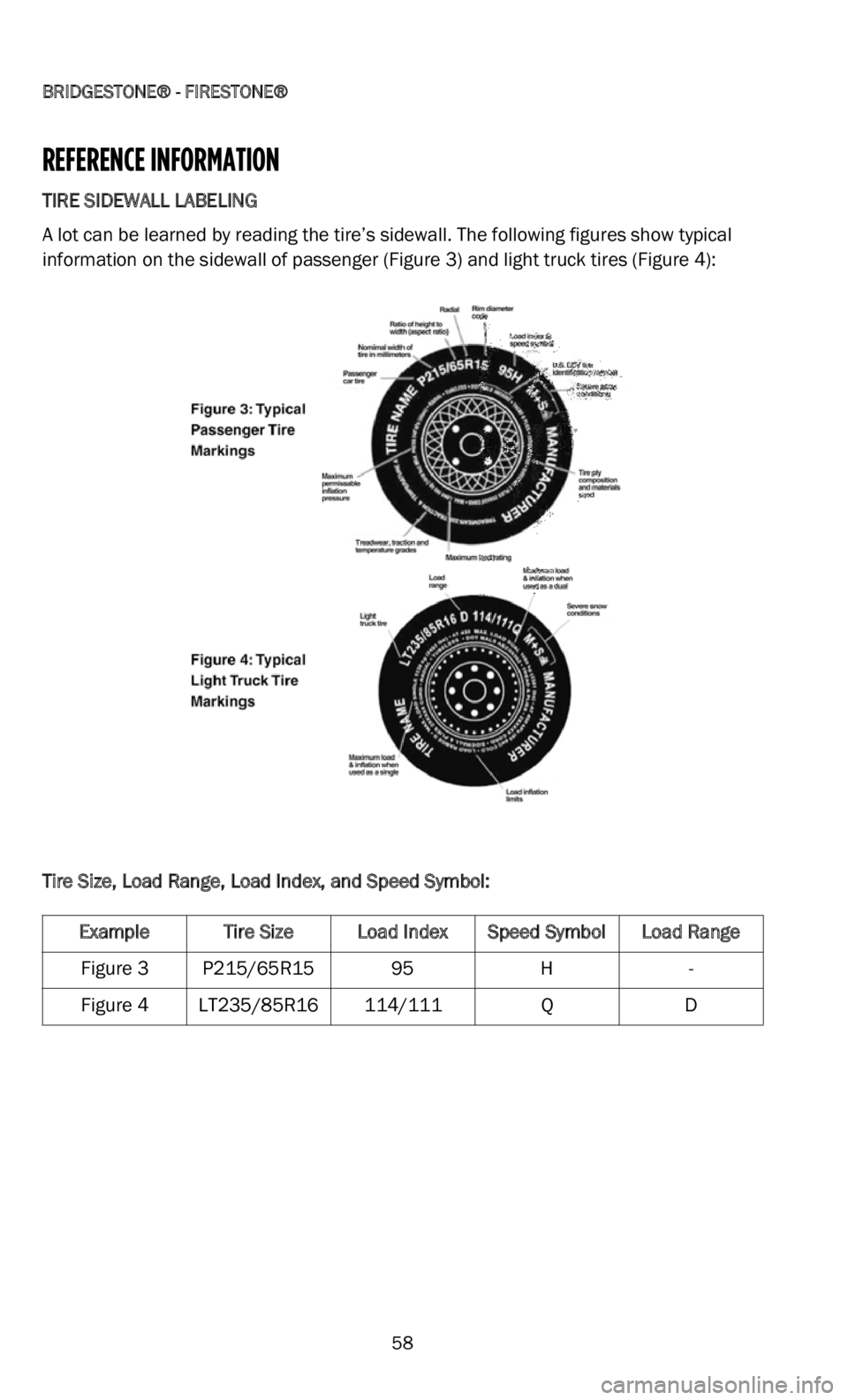
BRIDGESTONE® - FIRESTONE®
58
REFERENCE INFORMATION
TIRE SIDEWALL LABELING
A lot can be learned by reading the tire’s sidewall. The following figures show typical
in
formation on the sidewall of passenger (Figure 3) and light truck tires (Figure 4):
Tire Size, Load Range, Load Index, and Speed Symbol: Example Tire SizeLoad IndexSpeed Symbol Load Range
Figure 3 P215/65R15 95H-
Figure 4 LT235/85R16 114/111 QD
Page 60 of 200
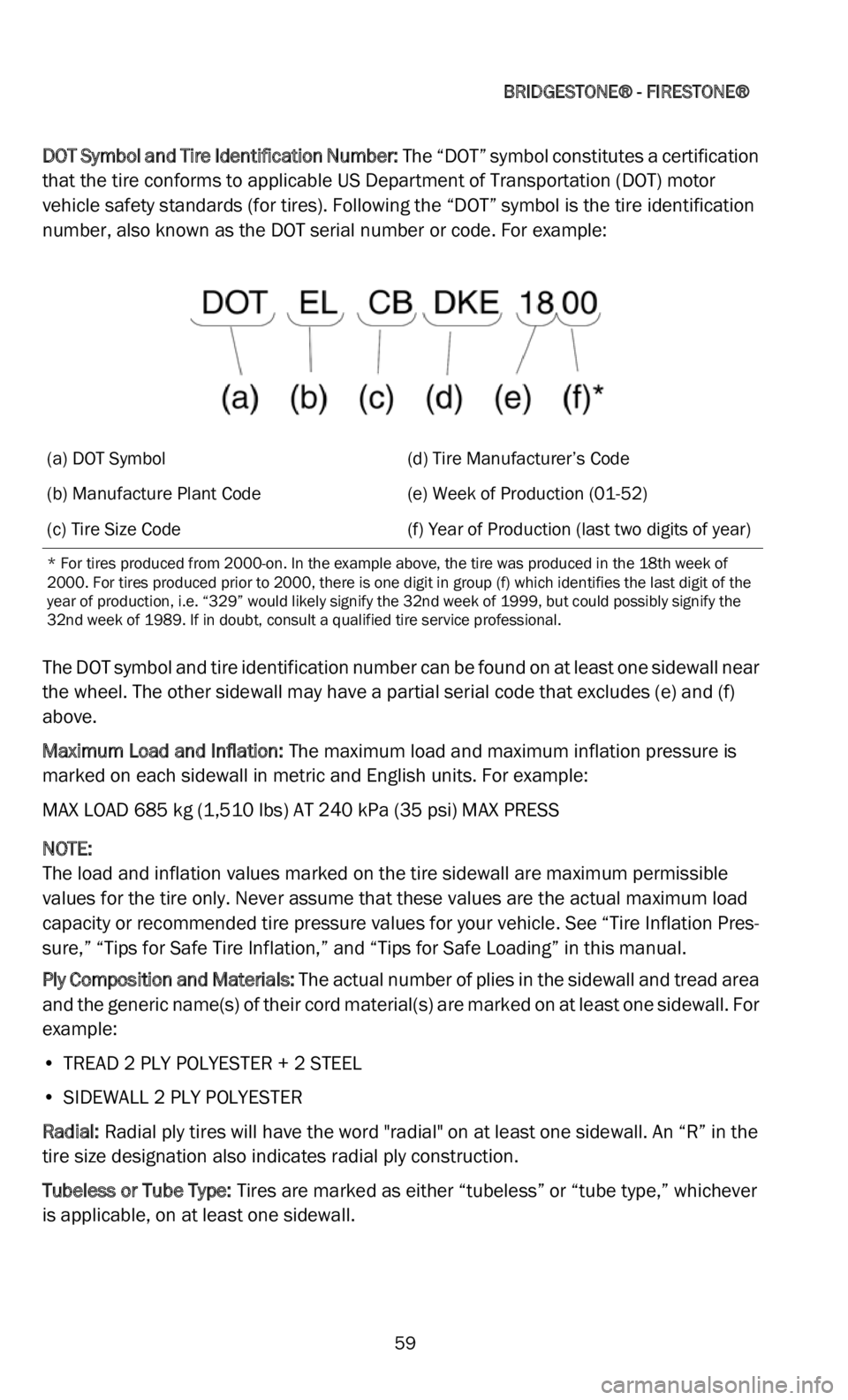
BRIDGESTONE® - FIRESTONE®
59
DOT Symbol and Tire Identification Number: The “DOT” symbol constitutes a certification
that the tire conforms to applicable US Department of Transportation (DOT) motor
vehicle safety standards (for tires). Following the “DOT” symbol is the tire identification
number, also known as the DOT serial number or code. For example:
The DOT symbol and tire identification number can be found on at least one sidewall near
th
e wheel. The other sidewall may have a partial serial code that excludes (e) and (f)
above.
Maximum Load and Inflation: T
he maximum load and maximum inflation pressure is
marked on each sidewall in metric and English units. For example:
MAX LOAD 685 kg (1,510 lbs) AT 240 kPa (35 psi) MAX PRESS
NOTE:
The load and inflation values marked on the tire sidewall are maximum permissible
v a
lues for the tire only. Never assume that these values are the actual maximum load
capacity or recommended tire pressure values for your vehicle. See “Tire Inflation Pres -
sure,” “Tips for Safe Tire Inflation,” and “Tips for Safe Loading” in this manual.
Ply Composition and Materials: T
he actual number of plies in the sidewall and tread area
and the generic name(s) of their cord material(s) are marked on at least one sidewall. For
example:
• T READ 2 PLY POLYESTER + 2 STEEL
•
SIDEWALL 2 PLY POLYESTER
R
adial: Radial ply tires will have the word "radial" on at least one sidewall. An “R” in the
t
ire size designation also indicates radial ply construction.
Tubeless or Tube Type: T
ires are marked as either “tubeless” or “tube type,” whichever
is applicable, on at least one sidewall.
(a) DOT Symbol (d) Tire Manufacturer’s Code
(b) Manufacture Plant Code (e) Week of Production (01-52)
(c) Tire Size Code (f) Year of Production (last two digits of year)
* For tires produced from 2000-on. In the example above, the tire was produced in the 18th week of
2000. For tires produced prior to 2000, there is one digit in group (f) which identifies the last digit of the
year of production, i.e. “329” would likely signify the 32nd week of 1999, but could possibly signify the
32nd week of 1989. If in doubt, consult a qualified tire service professional.